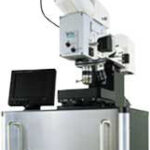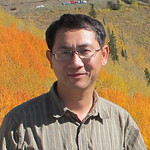Overview of Facilities
We are a multiuser facility designed to facilitate microscopy and imaging.
Equipment
High-Resolution Scanning Electron Microscope
 The FEI Nova NanoSEM™ scanning electron microscope is equipped with a field emitter electron source. Feature sizes of 2 nm can be resolved. There is a low vacuum feature which allows imaging of non-conducting samples without the need to coat the samples with a conductive layer (biological samples need no special preparation). An X-ray elemental analysis system is attached to allow identification of elements within a sample as well as elemental mapping. E-beam lithography can write an area of 170×170 microns with 40-nm linewidths.
The FEI Nova NanoSEM™ scanning electron microscope is equipped with a field emitter electron source. Feature sizes of 2 nm can be resolved. There is a low vacuum feature which allows imaging of non-conducting samples without the need to coat the samples with a conductive layer (biological samples need no special preparation). An X-ray elemental analysis system is attached to allow identification of elements within a sample as well as elemental mapping. E-beam lithography can write an area of 170×170 microns with 40-nm linewidths.
Confocal Optical Microscope / Micro-Raman / AFM / SNOM
 The WiTec AlphaSNOM™ system performs multiple functions by simply switching some components. These functions include general and confocal optical microscopy with submicron diffraction-limited spatial resolution, scanning micro-Raman spectroscopy with spectral-imaging capability and multiple laser excitation sources, atomic force microscopy, scanning near-field optical microscopy with a spatial resolution less than 100 nm.
The WiTec AlphaSNOM™ system performs multiple functions by simply switching some components. These functions include general and confocal optical microscopy with submicron diffraction-limited spatial resolution, scanning micro-Raman spectroscopy with spectral-imaging capability and multiple laser excitation sources, atomic force microscopy, scanning near-field optical microscopy with a spatial resolution less than 100 nm.
High-Resolution Spectroscopy
 This lab has several dedicated lasers and spectrometers for spectroscopy. There is an argon ion laser with discrete visible wavelengths from 457 to 514 nm, a krypton laser with wavelengths 646 and 674 nm, and a tunable titanium sapphire laser from 750 to 850 nm. There is a triple monochromator useful for low wavenumber shifts with a liquid nitrogen cooled CCD detector. There is a 0.85-m double monochromator coupled with a CCD detector or with a PMT and a photon counter for high-resolution spectroscopy.
This lab has several dedicated lasers and spectrometers for spectroscopy. There is an argon ion laser with discrete visible wavelengths from 457 to 514 nm, a krypton laser with wavelengths 646 and 674 nm, and a tunable titanium sapphire laser from 750 to 850 nm. There is a triple monochromator useful for low wavenumber shifts with a liquid nitrogen cooled CCD detector. There is a 0.85-m double monochromator coupled with a CCD detector or with a PMT and a photon counter for high-resolution spectroscopy.
Picosecond Spectroscopy
The picosecond lab has a modelocked picosecond laser that seeds a regenerative amplifier. The nd:yag based system has a fundamental wavelength of 1064 nm and pulse duration of 100 ps. This can be frequency doubled to 532 nm and frequency tripled to 355 nm. The modelocked laser has an average power of 600 mW at 532 nm and an 76 MHz repetition rate for an energy of about 8 nanojoules per pulse. The regenerative amplifer has an average power of 10 mW and repetition rate of 1000 Hz for an energy per pulse of 10 microjoules.
Femtosecond Spectroscopy
The femtosecond lab has a mode-locked femtosecond laser that seeds a regenerative amplifer. The titanium:sapphire based mode-locked laser operates at 800 nm and produces 100-fs pulses at 800 nm. The average power is 300 mW which gives an energy of 3.8 nanojoules per pulse. The regenerative amplifer produces an average power of 300 mW at a repetition rate of 1000 Hz for a pulse energy of 0.3 millijoules. Second and third harmonics at 400 nm and 266 nm are available. Additionally, there is an Optical Parametric Amplifier (OPA) that can give a continuous tuning range of 1.3 micron to 1.5 micron.

